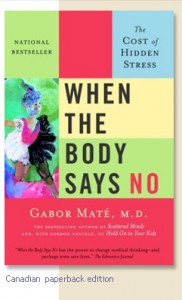Précis
A report commissioned by Health Canada on work-life conflict found that more than half of the 31,000 people surveyed reported high levels of stress. One in three suffered high levels of burnout and nearly 20 per cent rated their physical health as just fair-to-poor.
It’s no surprise that employees who are anxious and overloaded aren’t nearly as productive as those in good mental health. Stress, depression, and burnout are linked to increased absenteeism, and greater use of prescription medications and employee assistance programs. And chances are, the higher the level of stress within an organization, the lower the level of creativity and innovation which…has a negative impact on its bottom line and ability to compete.[i]
In the era of downsizing, Canadian workers have increased their workloads to keep up with diminishing budgets and fierce competition in all industries. There are physical, mental and social costs to these workers, with resultant financial and human resource costs on employers’ bottom line.
According to data from the 2003 Canadian Community Health Survey (CCHS), nearly one in three employed Canadians, about 5.1 million, reported that most days at work were “quite” or “extremely” stressful. Work-related stress costs Canadian taxpayers an estimated $2.8 billion annually in physician visits, hospital stays, and emergency room visits.[ii]
A 1992 United Nations report called job-related stress “the 20th Century disease”. Job-related stress syndromes cost $16 Billion/year in Canada…the equivalent of 14% all net profits, and a conservative estimate figures job-related stress is responsible for:[iii]
- 19% absenteeism
- 40% turnover (employee replacement costs 150-250% of their yearly salary)
- 55% Employee Assistance Programs (EAP)
- 30% short term and long term disability costs
- 60% of the total costs related to workplace accidents
- 10% drug plan costs are for psychotherapeutic prescriptions
“Stress generally has more of an impact on white-collar workers, on employees lower in the organizational ranks, in the services sector, and on women. Everyday small stressors are generally the most damaging. Each one of these stressors catalyzes 1,400 chemical reactions in your body, some of which continue for hours after the stressor that caused it has passed.
Individuals affected by stress smoke more, eat more, have more alcohol and drug-related problems, are less motivated, have more trouble with co-workers, and have more illness. Stress impairs the immune system and can result in more infectious diseases, chronic respiratory illnesses, high blood pressure, obesity, cardiovascular diseases, gastrointestinal disorders, depression and cancer. [iv]
In 2000/2001, over two million Canadians had a repetitive strain injury (RSI) serious enough to limit their normal activities, and 55% of these injuries were caused by work-related activities.[v]
In one study of Federal Government workers, there were between 11,000 and 17,000 RSI claims / year, with total work days lost between 45,000 – 73,000. The estimated cost of RSI to the workplace…$24 – $40 million annually.
Contributing factors include excessive work rates (and inadequate rest breaks); badly designed equipment, tools, machinery, and furniture; poor workstation layout that requires bending, twisting or stretching to perform a single task; chairs, desks and benches that are not suitable to a person’s height; and lack of job variation.
Progressive employers are looking for ways to support their employees with safer workplaces, more comfortable/ergonomic equipment and workplace wellness programs.
Workplace Wellness: An Antidote to Rising Health Claims and Low Productivity
Workplace wellness programs are instituted by progressive employers to boost morale and productivity, stem absenteeism, “presenteeism” and turnover and yield the benefits of a loyal, healthy workforce. Workplace wellness initiatives include: health screenings and biometrix, health fairs and information, occupational safety improvements, on-site paramedical interventions/therapies, exercise, walk-to-work and quit smoking/curb obesity programs. These programs are paid for directly by the employer or indirectly via employees utilizing their employee health benefit plans. Sixty-five percent of employees polled state a health benefits plan is a strong incentive to stay with their current employer.[vi]
According to Joan Burton, Senior Strategy Advisor, Healthy Workplaces, Industrial Accident Prevention Association (IAPA), the components of a healthy workplace include the organizational culture, physical work environment and the personal health resources an employee brings to the workplace. She states the cost of “doing nothing” puts an organization’s employees at risk for doubling or tripling the incidence of injuries, mental health problems, conflicts, substance abuse and other undesired outcomes.[vii]
According to Burton’s report, companies that incorporate workplace wellness programs experience strong benefits-to-cost ratio. Here are a few examples: BC Hydro: For every $1 spent on the organization’s wellness program, the company saved an estimated $3 (after running 10 years)
Canada Life Insurance: The company saved $3.43 for every $1 spent on its fitness program.
University of Michigan: For every $1 USD spent on workplace health programs, savings were estimated at $1.50 to $2.50 USD
Dupont (USA): For every $1 USD spent on a company health promotion program, the company saved $2.05 USD on disability after 2 years.
Citibank: For every $1 USD the company spent on its comprehensive health program, there was a savings of $4.56 USD.
Pillsbury Company: For every $1 spent on wellness, the company saved $3.63 in health-related costs.
8 Halifax organizations: For every $1 spent on wellness, these organizations saved $1.64 on average/person plus: $2.04 for participants with 3-5 risk factors and $3.35 for smokers
Coors Brewing Company: For every $1 spent on a fitness program, the company saved $6.15
Telus-BC: The company saved $3 for every $1 spent on corporate health initiatives
A large diversified multi-site industrial setting: For every dollar spent on workplace health promotion, $2.05 was saved after 2 years
One of the best investments an employer can make is in a healthy workforce.
Incorporate Massage Therapy into Your Workplace Wellness Program
Businesses and corporations provided employee benefit plans during North America’s economic boom to retain skilled workers. In the current economic recession, benefit plans help businesses mitigate job-related stress and repetitive strain injuries to promote healthy, productive and loyal employees. Many benefit plans include massage therapy services in their coverage.
Massage therapy is consistently recognized as an effective intervention to the effects of stress, strain and pain. Registered Massage Therapists (RMTs) are trained professionals, bound to ethics and standards under the Regulated Health Professions Act, and an essential component of paramedical care in our health care system.
In a study by Shulman and Jones posted in the Journal of Applied Behavioral Science, workers in a company experiencing downsizing participated in an on-site massage therapy program. These workers showed significant reductions in anxiety levels, compared to a control group that received a work-break but not massage therapy.[viii] Other studies confirm the positive effects of massage therapy on low back pain, carpal tunnel syndrome, headaches and depression.[ix]
Companies using massage therapy as part of their on-site corporate wellness program include American Express, Apple, At&T, Canadian Tire Acceptance, IBM, Merrill Lynch and State Farm Insurance. In a study conducted by the American Massage Therapy Association, 77% of Fortune 500 companies offer massage therapy in their benefit plans. Particularly, companies in the financial, insurance and technology sector recognize the impact to worker productivity, health and loyalty, and proactively provide workplace wellness programs.
[i] Ariganello, A. CPA http://www.cga-canada.org/en-ca/AboutCGACanada/CGAMagazine/2009/May-Jun/Pages/ca_2009_05-06_network_reflections.aspx
[ii] ibid
[iii] www.stresscosts.com
[iv] Tangri, R: Stress Costs Stress Cures, 2003. P 24
[v] Tjepkema M. Repetitive strain injury. Health Reports 2003; 14 (4): 11–30. [Statistics Canada, Catalogue 82-003].
[vi] Safoni Canada Health Care Survey 2011. P 7.
[vii] Burton, J: The Business Case for a Healthy Workplace. IAPA 2008
[viii] Shulman, KR & Jones, GE: The Effectiveness of Massage Therapy Intervention on Reducing Anxiety in the Workplace. Journal of Applied Behavioural Science, 32, 160-173
[ix] http://www6.miami.edu/touch-research/Massage.html
 Follow
Follow
